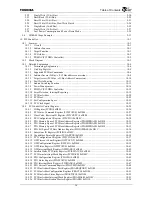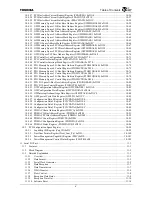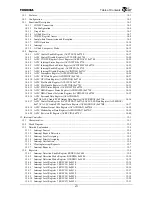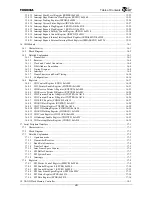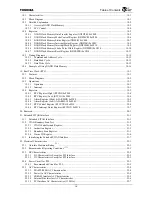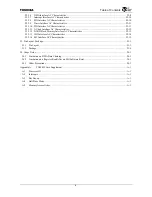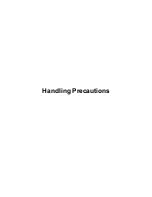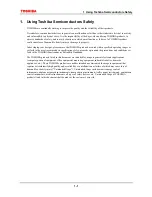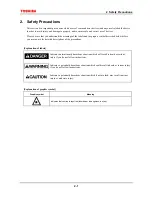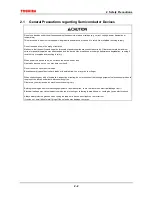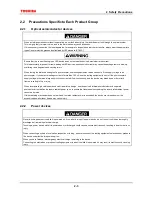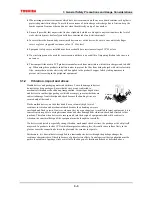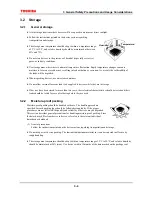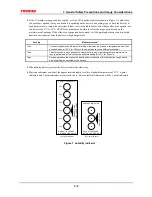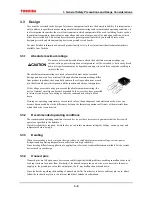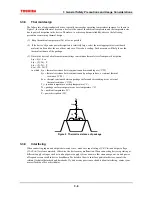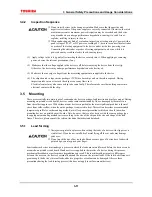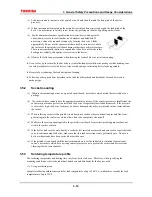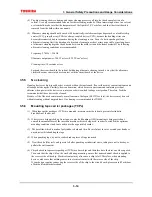
2 Safety Precautions
2-4
Do not use devices under conditions which exceed their absolute maximum ratings (current, voltage, power dissipation,
temperature etc.).
This may cause the device to break down, causing a large short-circuit current to flow, which may in turn cause it to catch fire or
explode, resulting in fire or injury.
Use a unit which can detect short-circuit currents and which will shut off the power supply if a short-circuit occurs.
If the power supply is not shut off, a large short-circuit current will flow continuously, which may in turn cause the device to catch
fire or explode, resulting in fire or injury.
When designing a case for enclosing your system, consider how best to protect the user from shrapnel in the event of the device
catching fire or exploding.
Flying shrapnel can cause injury.
When conducting any kind of evaluation, inspection or testing, always use protective safety tools such as a cover for the device.
Otherwise you may sustain injury caused by the device catching fire or exploding.
Make sure that all metal casings in your design are grounded to earth.
Even in modules where a device’s electrodes and metal casing are insulated, capacitance in the module may cause the
electrostatic potential in the casing to rise.
Dielectric breakdown may cause a high voltage to be applied to the casing, causing electric shock and injury to anyone touching
it.
When designing the heat radiation and safety features of a system incorporating high-speed rectifiers, remember to take the
device’s forward and reverse losses into account.
The leakage current in these devices is greater than that in ordinary rectifiers; as a result, if a high-speed rectifier is used in an
extreme environment (e.g. at high temperature or high voltage), its reverse loss may increase, causing thermal runaway to occur.
This may in turn cause the device to explode and scatter shrapnel, resulting in injury to the user.
A design should ensure that, except when the main circuit of the device is active, reverse bias is applied to the device gate while
electricity is conducted to control circuits, so that the main circuit will become inactive.
Malfunction of the device may cause serious accidents or injuries.
When conducting any kind of evaluation, inspection or testing, either wear protective gloves or wait until the device has cooled
properly before handling it.
Devices become hot when they are operated. Even after the power has been turned off, the device will retain residual heat which
may cause a burn to anyone touching it.
2.2.3
Bipolar ICs (for use in automobiles)
If your design includes an inductive load such as a motor coil, incorporate diodes or similar devices into the design to prevent
negative current from flowing in.
The load current generated by powering the device on and off may cause it to function erratically or to break down, which could in
turn cause injury.
Ensure that the power supply to any device which incorporates protective functions is stable.
If the power supply is unstable, the device may operate erratically, preventing the protective functions from working correctly. If
protective functions fail, the device may break down causing injury to the user.
Summary of Contents for TMPR4925
Page 1: ...64 Bit TX System RISC TX49 Family TMPR4925 Rev 3 0 ...
Page 4: ......
Page 15: ...Handling Precautions ...
Page 16: ......
Page 18: ...1 Using Toshiba Semiconductors Safely 1 2 ...
Page 40: ...3 General Safety Precautions and Usage Considerations 3 18 ...
Page 42: ...4 Precautions and Usage Considerations 4 2 ...
Page 43: ...TMPR4925 ...
Page 44: ......
Page 54: ...Chapter 1 Features 1 8 ...
Page 58: ...Chapter 2 Block Diagram 2 4 ...
Page 88: ...Chapter 4 Address Mapping 4 12 ...
Page 226: ...Chapter 8 DMA Controller 8 58 ...
Page 260: ...Chapter 9 SDRAM Controller 9 34 ...
Page 480: ...Chapter 15 Interrupt Controller 15 32 ...
Page 554: ...Chapter 19 Real Time Clock RTC 19 8 ...
Page 555: ...Chapter 20 Removed 20 1 20 Removed ...
Page 556: ...Chapter 20 Removed 20 2 ...
Page 564: ...Chapter 21 Extended EJTAG Interface 21 8 ...
Page 580: ...Chapter 22 Electrical Characteristics 22 16 ...
Page 588: ...Chapter 24 Usage Notes 24 2 ...

